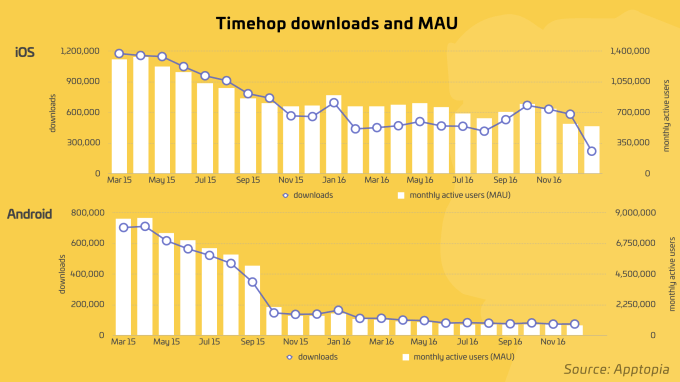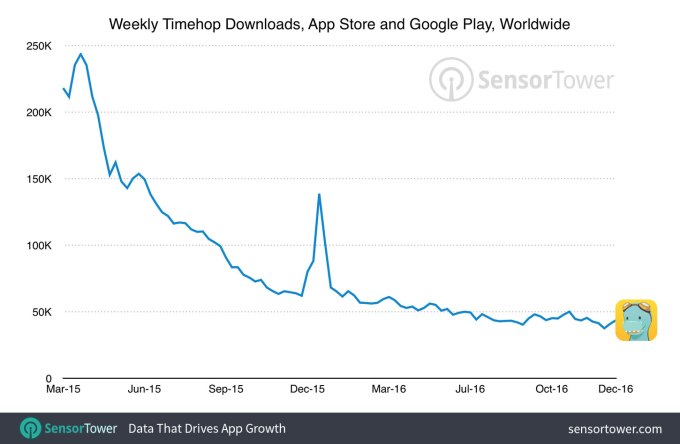Some changes at the top of Timehop, the quirky app that shows you reminders of photos and other content that you’ve taken and posted on Facebook, Twitter, Foursquare, Instagram and Flickr or from your camera roll. TechCrunch has learned and confirmed that Jon Wegener, who co-founded the company with Benny Wong, has stepped down as CEO. He has been replaced by Matt Raoul, who had been Timehop’s design lead. Also, Rick Webb, who had been VP of monetization and an early investor in the app, is now the startup’s COO.
We were first told about the CEO change by an anonymous tipster, who claimed the changes were made after an app update in December bombed with users. While we were finding some proof of the new roles, Wegener responded to a request for comment confirming his departure and the COO appointment.
“There’s a great team in place, and the company is profitable and healthy,” Wegener wrote.
Webb also responded directly to say he had been consulting at Timehop for the last year “building out the revenue side”. He also noted that the company is “on track to be permanently cash flow positive by March, with a mix of direct and programmatic ad sales.”
“We would also like to put to rest any concerns that Russia was involved in this transfer of power. It has been entirely peaceful and democratic,” he added.
Wegener told us that the changes are part of a longer plan for him to step away from the CEO role and not related to the recent update.
“I’ve been transitioning out of the company for the last few months,” he said, “haven’t been involved with the product at all recently, so my departure has nothing to do with the new version.” He said that there will be more about his new role in the next week or two.
More generally, Timehop’s numbers speak of the bigger competitive forces that have swirled around it.
Timehop was first founded in 2011 after Wegener and Wong built the basic coding of the app at a Foursquare hackathon with the original app name: “4SquareAnd7YearsAgo” to replay past Foursquare check-ins.
The two had been working on another app together at Techstars but decided to switch to developing the Foursquare hack into a full-fledged business after seeing a lot of positive response to the concept. They extended it to Facebook posts and then Instagram photos before merging everything into Timehop. Eventually, it the app added more content sources.
Timehop caught on with millions of users, for whom it essentially served as a kind of counterbalance to the rise of Snapchat and its concept of ever-disappearing, ephemeral content. It was a fun, easy and instant archive, welcomed and used in a world otherwise filled with fast-moving, always-updating information and a lot of fragmentation, with pieces of our digital selves deposited across a multitude of places.
Timehop eventually raised just over $14 million in funding, with investors including Shasta Ventures, Spark Capital and Oreilly AlphaTech Ventures, as well as a number of individual investors, including Foursquare’s Dennis Crowley and Naveen Selvadurai, Alex Rainert and Randi Zuckerberg.
But unfortunately, having a Zuckerberg on the cap table wasn’t enough to keep Facebook from moving in.
In March 2015, just after Timehop hit 12 million downloads and 6 million daily users, the world’s biggest social network launched its own version of Timehop just for Facebook posts called On This Day.
As you can see in this table we’ve put together with data from Apptopia, Timehop’s own usage gradually began to decline on both iOS and Android after that point:

Further to this, data provided to us by Sensortower, showed that downloads in the U.S. between Q4 2015 and Q4 2016 declined by 38 percent across the two major mobile platforms combined. Sensortower also provided the merged figures in a table of weekly downloads, which also illustrates the drop pretty well:

This essentially goes to show that Timehop has been relying more than perhaps other apps on having strong loyalty and engagement from existing users, and could explain why having a poor response from those users would have been an especially bad turn of events.
Timehop, now under the charge of a new executive team, says it is quietly getting profitable, and I sincerely hope that is the case. For now, it appears to be doing so on a far smaller scale than its outsized competitor.
A year after Facebook launched On This Day, it noted 60 million daily visitors and 155 million subscribers (perhaps not that hard when your user base is approaching 2 billion people, and you’ve quickly become a default location for where many browse online and already share pictures anyway). It’s only anecdotal, but I feel like I’ve been getting pushed many more of these nostalgic On This Day post suggestions lately, and have seen more of them getting shared — perhaps one of the ways that Facebook is trying to make sure more of us engage on its platform.
Updated with more information from Wegener.
